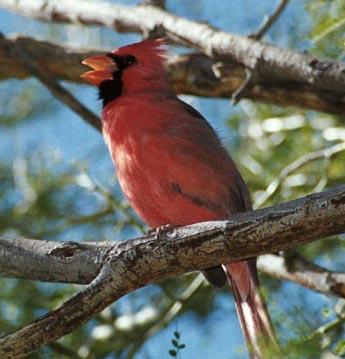Call of the Wild

Northern cardinal singing
by Val Cunningham
Contributing Writer
Bird songs are designed to attract a mate or repel a rival, but birds have other things they need to communicate. Pairs need to stay in contact, flocks confer back and forth and a bird that notices a potential attacker will issue a warning. For these and other purposes birds rely on calls—a repertoire of short, unmusical sounds that convey specific information. Unlike a bird’s song, much of which is learned, bird calls are instinctual, an innate means of communicating.
Calls may be loud, such as the crow’s “caw, caw” or might be very soft, like the “tssp” sound used by a hiding robin to warn others that danger is nearby.
Chickadees call “chick-a-dee-dee,” to sound an alarm, call to the flock and warn off low-ranking birds (their song is a soft, whistled “fee-bee-bee”). When a chickadee gives a high-pitched “see-see” sound it’s warning of clear and present danger, such as the presence of a bird-eating hawk.
Cardinals have 10 or more distinct calls, with the most familiar being a loud, metallic “chip.” Cardinals get a lot of use out of that sound: late in the day it may signal that the caller is heading to his night roost. Mid-day it might mean danger is around, while in nesting season it may mean one parent is approaching the nest. Sometimes it’s a contact note between a cardinal pair. There must be nuances in the sound that bird ears pick up.
Blue jays are noisy, aggressive birds with a variety of sounds for various purposes. That familiar, loud “jeer” may announce that a blue jay is coming in to feed, or is intended to frighten smaller birds away from feeders to allow the jay easy access. Jays are excellent parents, intolerant of any threat to their brood, and make ear-splitting raucous calls to drive intruders away.
Their cousins, the crows, have more than 20 different calls. One of the most interesting is the rattle call, sounding like castanets, given when a crow is excited. There’s the familiar multi-purpose “caw,” plus a sort of “ack-ack” sound and crows sometimes click their beaks. Crows at their nighttime roosts make an astonishing amount of noise as they gossip with their neighbors long past nightfall.
Mourning dove wings make a loud whistle when the birds take off or land quickly, a sound that seems designed to startle an intruder or warn flock mates of danger.
Goldfinches are noisy little birds that, like all flocking birds, chatter a great deal to stay in touch with each other. A single goldfinch flying overhead while calling “per-chick-o-ree” is staying in touch with his or her flock. These birds often choose to gather together to feed and their high-pitched “see-seeEEd” call may be issuing a dinner invitation.
Downy woodpeckers aren’t songbirds, but can convey a wide range of messages with a variety of short calls. A loud “teak” note is usually used by one member of a pair to stay in contact with the other. A descending whinny can be used as a contact call or to signal aggression.
Songbirds and woodpeckers are great communicators and since they aren’t solitary there’s a great deal to communicate with other birds. Keep an ear out for some fascinating “tweets” from the bird world.
St. Paul, Minnesota resident Val Cunningham, leads bird hikes for the St. Paul Audubon Society and writes about nature for local, regional and national newspapers and magazines.



